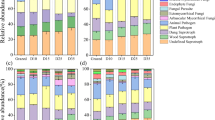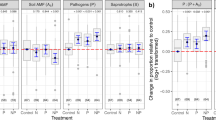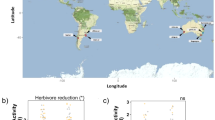Abstract
Background and aims
Fungi play vital roles in organic matter decomposition, and mineralisation of phosphorus and nitrogen, are significant plant and animal pathogens, and major mutualistic symbionts with the roots of higher plants. Despite their importance, relatively little is known about the effects of livestock grazing on different functional groups of fungi.
Methods
We used structural equation modelling to examine how grazing by domestic livestock and native herbivores, and aridity, plant cover and soil carbon influenced four functional groups of soil fungi (ectomycorrhizal fungi, arbuscular mycorrhizal fungi, dung saprobes, plant pathogens) from three microsites (tree, shrub, grass) at 54 woodland sites across 0.4 million km2 of dryland in eastern Australia.
Results
Structural equation modelling showed that aridity influenced fungi indirectly by affecting different herbivores and by changing plant cover, which had different effects on different fungal groups. Rabbit grazing had a direct negative effect on ectomycorrhizal and arbuscular mycorrhizal fungi, most likely by disrupting hyphal networks through soil disturbance. Increased cattle grazing was directly positively associated with fungal dung saprobe abundance, and indirectly, negatively associated with dung saprobes by suppressing the positive effects of soil carbon. Sheep had direct and indirect negative effects on the abundance of plant pathogens.
Conclusions
Grazing was always an important predictor of the relative abundance of all fungal groups, either directly or indirectly. Thus, overgrazing is likely to have substantial effects on a range of important soil processes controlled by these microorganisms. Overall, our work indicates that increasing grazing, linked to on-going land use intensification to support a growing global population, will have major impacts on fungal functional groups.






Similar content being viewed by others
References
Andrews S (2010) FastQC: a quality control tool for high throughput sequence data. Available online at: http://www.bioinformatics.babraham.ac.uk/projects/fastqc
Archer E (2016) rfPermute. Permutation P-values for Random Forest Importance Metrics. V2.1.5
Berg G, Smalla K (2009) Plant species and soil type cooperatively shape the structure and function of microbial communities in the rhizosphere. FEMS Microbiol Ecol 68:1–13
Breiman L (2001) Random forests. Mach Learn 45:5–32
Cournane FC, McDowell R, Littlejohn R, Condron L (2011) Effects of cattle, sheep and deer grazing on soil physical quality and losses of phosphorus and suspended sediment losses in surface runoff. Agric Ecosyst Environ 140:264–227
De Deyn GB, Quirk H, Bardgett RD (2011) Plant species richness, identity and productivity differentially influence key groups of microbes in grassland soils of contrasting fertility. Biol Lett 7:75–78
Delgado-Baquerizo M, Maestre FT, Gallardo A, Bowker MA, Wallenstein MD, Quero JL et al (2013) Decoupling of soil nutrient cycles as a function of aridity in global drylands. Nature 502:672–676
Dickinson CH, Underhay VHS (1977) Growth of fungi in cattle dung. Trans Br Mycol Soc 69:473–477
Ducousso M, Duponnois R, Thoen T, Prin Y (2012) Diversity of ectomycorrhizal fungi associated with eucalyptus in Africa and Madagascar. Int J For Res 2012:1–10. https://doi.org/10.1155/2012/450715.ID450715
Edgar RC (2013) UPARSE: highly accurate OTU sequences from microbial amplicon reads. Nat Methods 10:996–998
Edgar RC, Haas BJ, Clemente JC, Quince C, Knight R (2011) UCHIME improves sensitivity and speed of chimera detection. Bioinformatics 27:2194–2200
Eldridge DJ, Delgado-Baquerizo M, Travers SJ, Val J, Oliver I (2016) Do grazing intensity and herbivore type affect soil health? Insights from a semi-arid productivity gradient. J Appl Ecol 54:976–985
Eldridge DJ, Poore AGB, Ruiz-Colmenero M, Letnic M, Soliveres S (2016b) Ecosystem structure, function and composition in rangelands are negatively affected by livestock grazing. Ecol Appl 36:1273–1283
Grace JB (2006) Structural equation modelling and natural systems. Cambridge University Press, UK
Ihrmark K, Bodeker ITM, Cruz-Martinez K, Friberg H, Kubartova A, Schenck J et al (2012) New primers to amplify the fungal ITS2 region - evaluation by 454-sequencing of artificial and natural communities. FEMS Microbiol Eco 82:666–677
Joergensen RG, Emmerling C (2006) Methods for evaluating human impact on soil microorganisms based on their activity, biomass, and diversity in agricultural soils. J Plant Nutr Soil Sci 169:295–309
Kõljalg U, Nilsson RH, Abarenkov K, Tedersoo L, Taylor AFS, Bahram M et al (2013) Towards a unified paradigm for sequence-based identification of fungi. Mol Ecol 22:5271–5277
Lamb EG, Kennedy N, Siciliano SD (2011) Effects of plant species richness and evenness on soil microbial community diversity and function. Plant Soil 338:483–495
Maestre FT, Delgado-Baquerizo M, Jeffries TC, Eldridge DJ, Ochoa V, Gozalo B et al (2015) Increasing aridity reduces soil microbial diversity and abundance in global drylands. Proc Natl Acad Sci U S A 112:15684–15689
Maestre FT, Eldridge DJ, Soliveres S, Kéfi S, Delgado-Baquerizo M, Bowker MA et al (2016) Structure and functioning of dryland ecosystems in a changing world. Annu Rev Ecol Evol Syst 47:215–237
Magoč T, Salzberg SL (2011) FLASH: fast length adjustment of short reads to improve genome assemblies. Bioinformatics 27:2957–2963
Marques FFC, Buckland ST, Goffin D, Dixon CE, Borchers DL, Mayle BA et al (2001) Estimating deer abundance from line transect surveys of dung: sika deer in southern Scotland. J Appl Ecol 38:349–363
Miller RN, Reinhardt DR, Jastrow JD (1995) External hyphal production of vesicular–arbuscular mycorrhizal fungi in pasture and tallgrass prairie communities. Oecologia 103:17–23
Nguyen NH, Song Z, Bates ST, Branco S, Tedersoo L, Menke J et al (2016) FUNGuild: an open annotation tool for parsing fungal community datasets by ecological guild. Fungal Ecol 20:241–248
Reiter N, Lawrie A, Walsh N (2013) The mycorrhizal associations of Borya mirabilis, an endangered Australian native plant. Muelleria 31:81–88
Rillig MC, Mummey DL (2006) Mycorrhizas and soil structure. New Phytol 171:41–53
Schermelleh-Engel K, Moosbrugger H, Müller H (2003) Evaluating the fit of structural equation models: Tests of significance and descriptive goodness-of-fit measures. Method Psych Res Online 8:23–74
Schloss PD, Westcott SL, Ryabin T, Hall JR, Hartmann M, Hollister EB, Lesniewski RA et al (2009) Introducing mothur: Open-source, platform-independent, community-supported software for describing and comparing microbial communities. Appl Environ Microbiol 75:7537–7541
Srivastava R, Aragno M, Sharma AK (2010) Cow dung extract: a medium for the growth of pseudomonads enhancing their efficiency as biofertilizer and biocontrol agent in rice. Indian J Microbiol 50:349–354
Steinfeld H, Gerber P, Wassenaar T, Castel V, Rosales M, de Haan C (2006) Livestock’s long shadow. Environmental Issues and Options. FAO: Rome
Treseder, K.K., Lennon, J.T., 2015. Fungal traits that drive ecosystem dynamics. Microbiol Mol Biol Rev 79, 243–262
Van der Heyde M, Ohsowski B, Abbott LK, Hart M (2017) Mycorrhizal fungus responses to disturbance are context-dependent. Mycorrhiza 27:431–440
Wang Q, Garrity GM, Tiedje JM, Cole JR (2007) Naive Bayesian classifier for rapid assignment of rRNA sequences into the new bacterial taxonomy. Appl Environ Microbiol 73:5261–5267
Wei C-L, Rowe GT, Escobar-Briones E, Boetius A, Soltwedel T, Caley MJ et al (2010) Global patterns and predictions of seafloor biomass using random forests. PLoS One 5:e15323
Yokoya K, Kai H, Koga T, Aibe T (1991) Nitrogen mineralization and microbial populations in cow dung, dung balls and underlying soil affected by paracoprid dung beetles. Soil Biol Biochem 23:649–653
Acknowledgements
We thank James Val and Samantha Travers for all aspects of field work, Marta Ruiz-Colmenero, James Glasier and staff from OEH, Umwelt and Ecology Australia for assistance with some data collection and management, and Sarah Carr and Ian Oliver for project management. We thank two anonymous reviewers and Dr. Thomas Kuyper, Section Editor, for their positive comments that have helped improve the manuscript.
Author information
Authors and Affiliations
Corresponding author
Additional information
Responsible Editor: Thom W. Kuyper.
Electronic supplementary material
ESM 1
(DOCX 36 kb)
Rights and permissions
About this article
Cite this article
Eldridge, D.J., Delgado-Baquerizo, M. Functional groups of soil fungi decline under grazing. Plant Soil 426, 51–60 (2018). https://doi.org/10.1007/s11104-018-3617-6
Received:
Accepted:
Published:
Issue Date:
DOI: https://doi.org/10.1007/s11104-018-3617-6




